|

CHEESE EATER
By Dave Hood, GMT2, USS McKean (DD 784)
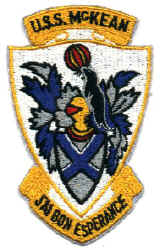 Remember when you were out at sea for months at a time? What were your thoughts
about returning to port? What were your plans? Mine were about getting off the
ship, chasing girls, drinking beer (in the hopes of meeting girls), going to the
movies (in the hope of meeting girls), going to a restaurant and eating real
food (with the hope that I can score with the waitress), going for a long scenic
drive (with a girl as a passenger, or course), and sleeping over at a girl’s
house.
Remember when you were out at sea for months at a time? What were your thoughts
about returning to port? What were your plans? Mine were about getting off the
ship, chasing girls, drinking beer (in the hopes of meeting girls), going to the
movies (in the hope of meeting girls), going to a restaurant and eating real
food (with the hope that I can score with the waitress), going for a long scenic
drive (with a girl as a passenger, or course), and sleeping over at a girl’s
house.
The last thing in the world that I
wanted to do was to escort a “_@#!+& stinkin’ rat across Puget Sound.
In September of
1978 the USS McKEAN DD-784 just returned to its homeport of Seattle, Washington
after spending the summer out at sea. It hadn’t been an especially good
cruise. We had a new CO aboard. The previous skipper, Cdr. Larry L. Smith, was
very popular. He was a true Cold Warrior, an excellent ship driver and loved to
fire the ship’s weapons. When the
crew did well he showed his appreciation.
The new CO
didn’t have the charisma of Smith. Through no fault of his, we also had some
mishaps: a vendor delivered us contaminated lube oil.
We had a near-disastrous Un-rep with a Royal Navy oiler.
A few of our Sonar Techs jumped ship. (On liberty they discovered some
girls. Come the next morning, they had a choice-get underway or stay with the
girls. The girls won out. ). We hit
some heavy seas and suffered some rather serious hull and equipment damage.
During a war game we lost a bearing in a reduction gear and had to pull
into Alameda for repairs. The ship
store ran out of chewing tobacco.
When we finally
made port, we were looking forward to a fairly long stand-down period.
The ship’s office was flooded with Leave Chits.
For a week the ASROC crew was busy chasing running rust, painting
scuppers and waterways, boot-topping the deck and replacing lifelines. (The deck
just takes a beating from the blast of the ASROC missiles.)
 Now that our spaces were looking good it was our turn for some serious goof-off
time. The division was dumbfounded
when our division officer read us the POD (plan of the day):
Now that our spaces were looking good it was our turn for some serious goof-off
time. The division was dumbfounded
when our division officer read us the POD (plan of the day):
“In order to
promote good will between the United States Navy and the local community, and to
honor the 50th birthday of WALT DISNEY’s character Mickey Mouse.
The U.S.S. McKEAN will on 16 September 1978 transit from her berth at Pier 90
Seattle to Puget Sound Naval Shipyard and moor alongside the mothballed
battleship USS MISSOURI. From there she will receive Mickey Mouse, (unit of
issue; 1 each) and transport Mr. Mouse across Puget Sound and deliver him to
Seattle’s Pier 70. Once safely delivered, the U.S.S. McKEAN will then sail
back to Pier 90.
Fair winds and
following seas.
Signed,
Commanding Officer, 13th Naval District.”
The memo ended with
a note from the CO- “This will be a dependant’s cruise. You are encouraged
to invite aboard your wives and children.”
“You have got to be @^*%%*&$
us, sir,” said Varga.
“What the $&#*?” said
Turner.
“Holy @^*%!” said Collier.
“Oh $&#( me.” said Ring.
“Cool! We might meet some
girls!” said Piper.
“Piper, you moron. Think about
the girls that are going to be at Mickey Mouse’s birthday party. There won’t
be any older then 12!”
“Oh. Yeah. I didn’t think about
that. Hey! What about their moms’?”
“Piper! Shut up!”
Around midnight
of Friday turning into Saturday, the Boiler Techs from the off-going and
on-coming duty sections wandered on down into their fire rooms and started to
light fires in their boilers.
The Machinist
Mates would report aboard slightly before reveille.
They had to get vacuum in the main condensers and do a proper warm up.
They couldn’t rush the job because the 600-psi steam system in the
GEARING-class plants had flange and bolt gasketed steam and water line
connections. To rush was to just
beg for steam leaks. Other members of the engine room crew would arrive
to relieve the light-off crew for breakfast and things just seemed to progress
effortlessly; there was no schedule, no orders, everybody knew where they were
going to be when "Sea & Anchor Detail" was piped and that they had
somebody who needed relieving for chow.
The Electrician Mates would arrive just slightly before
reveille and prepare the ship for the transfer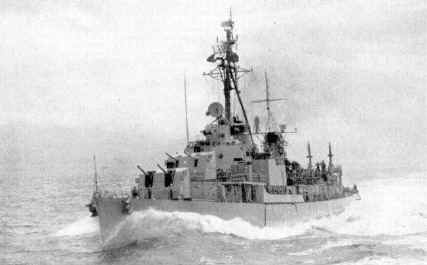 from shore power to ship’s power.
from shore power to ship’s power.
The first E-6 to report aboard had the most important
light-off procedure of all to perform. He had to fire up the coffee pot in the
“Lifer Locker.”
We set Sea And Anchor under typical Seattle gray skies
and an occasional drizzle. According to the Navy, it was summer time and the
proper uniform on the momentous occasion was “Salt and Peppers” – Navy
blue dress slacks and a white ironed shirt, polished leather shoes and a white
combination cap. (Thank you Admiral
Zumwalt.) It was far from being the perfect uniform for men to work with a wet
3” manila mooring line. Factor in rain and wind and you have a soggy, miserable and
thoroughly annoyed line handling crew. (Occasions
like those were the only times we envied snipes in their warm and dry holes.)
The transit from Seattle to PSNS Bremerton is a short one
– about 30 minutes. Too short a trip to even secure from Sea And Anchor.
We sailed past the shipyard and towards the mothball fleet at the far end
of Sinclair Inlet. Most of us had
never seen a real battleship before but we quickly recognized the MISSOURI’s
silhouette. Only the SEARS TOWER in Chicago and HOOVER DAM in Nevada seemed
bigger to me.
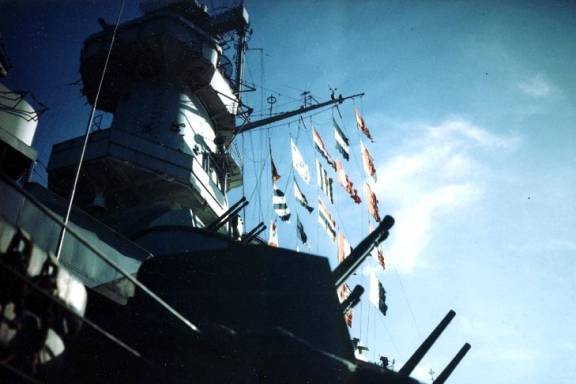
A 1944 photo of the MISSOURI. While my story takes place 34 years later, the
perspective was the same.
As we drew closer to the
battleship’s hull I became aware of two very different things.
1)
I had no idea how we were going to toss a heaving line up onto the
MISSOURI’s main deck, and
2)
I’m hearing music. Goofy (no pun intended) music.
The Puget Sound Naval Shipyard Band
is performing from the deck of the MISSOURI.
It was the theme song from THE
MICKEY MOUSE SHOW.
“Who’s the leader of the club
that’s made for you and me?
M-I-C
K-E-Y
M-O-U-S-E
Hey there, hi there, ho there
You’re as welcome as can be.
M-I-C
K-E-Y
M-O-U-S-E”
We managed to
get ourselves moored to the MISSOURI and an accommodation ladder was lowered
down to our flight deck. Well, almost. Either the MISSOURI was too big, we were
too small or the ladder was too short. The bottom of the ladder was about 3 feet
above the deck. All of the waiting high-ranking brass and muckety-mucks had to
jump down to board the McKEAN. Finally it was Mickey’s turn. We were expecting
a very tall mouse wearing a smile and pantaloons to come aboard. Instead, we got
a short old guy with two big suitcases. He tossed the suitcases to a crewmember
and then leaped down onto our flight deck.
Accompanying the short old guy with the suitcases was the PSNS band. One
by one, they came down the ladder, handed down their instruments and leaped
aboard.
A junior officer
escorted the short old guy to the wardroom, the PSNS band started playing M-I-C-K-E-Y,
we cast off our lines and we set sail back for Seattle. After the band played
the Mickey Mouse Theme Song a few dozen times they then started playing ANCHORS
AWEIGH.
Stand, Navy, out
to sea, Fight our battle cry;
We'll never change our course, So vicious foe steer shy-y-y-y.
Roll out the TNT, Anchors Aweigh. Sail on to victory
And sink their bones to Davy Jones, hooray!
Anchors Aweigh,
my boys, Anchors Aweigh.
Farewell to college joys, we sail at break of day-ay-ay-ay.
Through our last night on shore, drink to the foam,
Until we meet once more. Here's wishing you a happy voyage home.
Those “drum and stumble” warriors played those two songs, over and over.
It didn’t stop for the entire transit. The weather got worse. The winds
kicked up and the seas got choppy. We didn’t mind that too much. It helped to
muffle out the band.
At right,
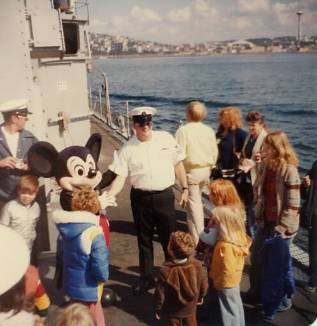 Mickey
and FTG2 Dave "Dog" Carlson. Moments
after this picture was taken the weather got nasty. Mickey
and FTG2 Dave "Dog" Carlson. Moments
after this picture was taken the weather got nasty.
As we approached Seattle things got even more bizarre. We could hear
“M-I-C-K-E-Y” in the distance and “Anchors Aweigh, my boys” up close -
both being played at the same time. We couldn’t figure out how the PSNS band
was doing that. The answer became
apparent as we neared Pier 70. The Naval Support Activity, Seattle (NSA) band
was at the head of the pier. They were playing the one tune with as much
enthusiasm and gusto as the PSNS band was playing the other. Since they were
each playing over the other their respective bandleaders had them do the only
sensible thing possible –play their instruments louder!
The wind was really kicking up and it made getting alongside of the pier very
difficult. Every time we tried to
get a heaving line over it kept falling short of the pier and they went
“ka-plop” into the water. With each command to have one engine go ahead 1/3
and the other engine to go astern 1/3 the wind would just kick up harder and
blow the ship further and further from the pier. When we finally could get a
heaving line over the ship would slip away and the line handler on the pier
would have to let it fall back into the water.
While all of this is going on, the short old guy had put on his Mickey Mouse
costume and took up station on the port bridge wing. He’s standing there
waving to the crowds. The crowds are waving back to Mickey and the mouse is
waving back to the crowds. (The
short old guy really was sort of short so to been over the bridge railing, he
had to stand on a box).
The ship just couldn’t get close to the pier. Every time the wind blew us too
far away. We finally backed away
from the pier and started forward again – this time with a few extra knots
dialed in. And then the wind died.
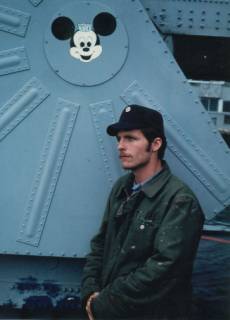 The Mouse
was still standing on his perch waving to the crowd.
The ship was making an approach on to the pier. The wind that the OOD was
compensating for wasn’t there anymore. The
mouse stopped waving “Hello boys and girls” with one hand and started waving
“Get the hell out of the way” with both hands. Just in time, the public
sensed the urgency in the mouse’s body language and ran away. Our bow
sliced into the pier like a cheese cutter slicing into a cheddar log. Several
8” x 8” x 20’ timbers were torn apart and their splinters were tossed
hither and yonder. The McKEAN’s bow ended up with a crease that looked like a
hair-lip trying to smile. And the
mouse got catapulted over the bridge railing.
The Mouse
was still standing on his perch waving to the crowd.
The ship was making an approach on to the pier. The wind that the OOD was
compensating for wasn’t there anymore. The
mouse stopped waving “Hello boys and girls” with one hand and started waving
“Get the hell out of the way” with both hands. Just in time, the public
sensed the urgency in the mouse’s body language and ran away. Our bow
sliced into the pier like a cheese cutter slicing into a cheddar log. Several
8” x 8” x 20’ timbers were torn apart and their splinters were tossed
hither and yonder. The McKEAN’s bow ended up with a crease that looked like a
hair-lip trying to smile. And the
mouse got catapulted over the bridge railing.
Mickey was using those oversized gloved hands to hold onto a lifeline for,
well…, his dear life. There was nothing under him but Puget Sound and
splintered pier timbers. The Deck Apes grabbed hold of Mickey and pulled him
back aboard. The crowd cheered and
the two bands finally quit playing.
Once we got back to our home at Pier 90, STGSN Piper painted a picture of Mickey
onto the ASROC launcher’s torque tube cover. The next day we were ordered to
paint it over. That was one
incident the wardroom wanted to forget.

 

|
